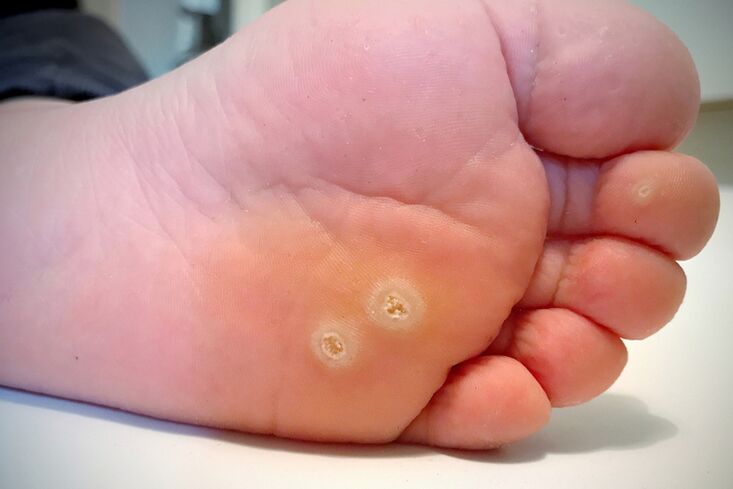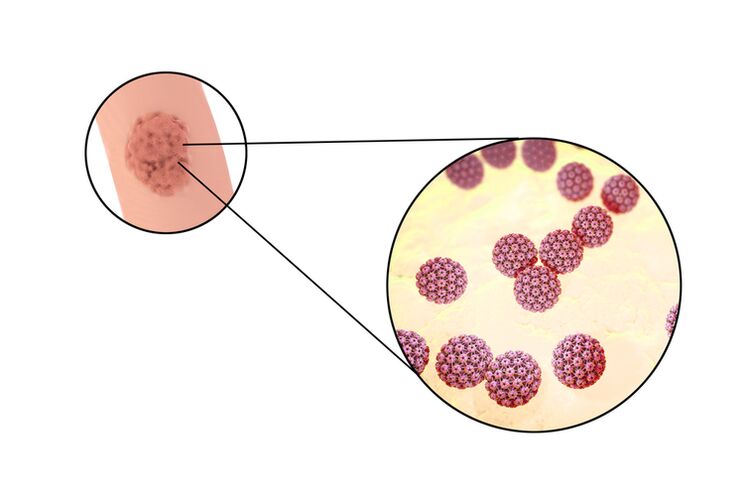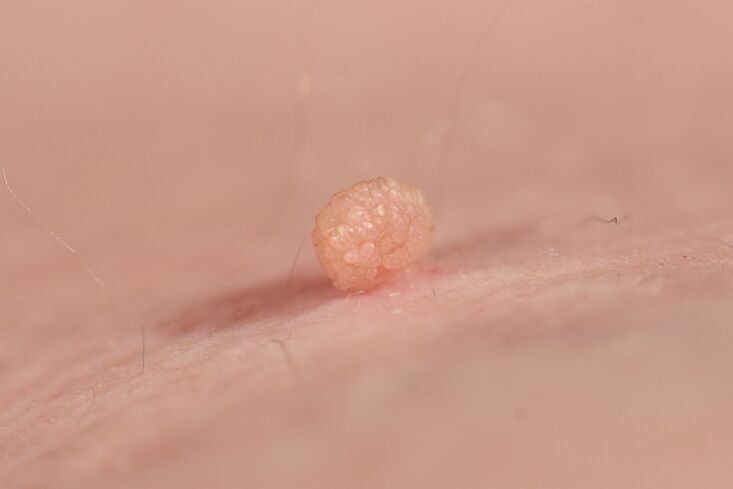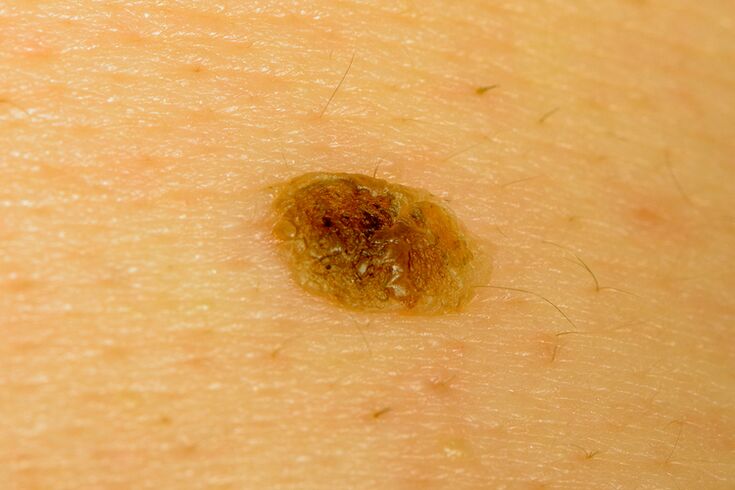
There are very few people who would not face a problem like warts on the body. These growths on the body can occur in adolescents, adults and the elderly. Usually warts are just a cosmetic problem that worsens a person's appearance. And only in rare cases do these formations actually pose a threat to health.
What is a wart?
Our skin has a smooth surface. However, in some cases, protruding skin growths may appear. These are called warts. These are usually permanent formations that do not change for many years.
The mechanism of wart formation is the growth of the upper layer of the skin. The dimensions of the formations range from 1 mm to several centimeters. This parameter depends on the type of formation and its location on the skin. Convergence of several warts is often observed. The color of the skin growths is usually the flesh, but they can take on other shades such as pink or brown.
Medicine warts are classified as benign neoplasms. They do not grow and do not enter the surrounding tissues.
In the International Classification of Diseases, warts are assigned the following codes:
- B07 - viral warts,
- A63. 0 - venereal wart,
- L82 Seborrheic Keratoma
Most types of warts are viral, sexually transmitted warts are venereal, and seborrheic keratomas are senile warts that are not infectious.
The following skin lesions must be distinguished from the wart:
- nevi (moles),
- kalusi,
- malignancies,
- basal cell carcinoma,
- extensive warts caused by syphilis.
Some of these formations can be life threatening. Therefore, if a suspicious formation appears on the body, it is necessary to consult a doctor.
Why do warts occur?
Usually, a viral infection is the cause of warts. The process of wart formation is as follows. The human papillomavirus enters skin cells and causes them to break down quickly. As a result, growths or papillomas develop on the skin. However, there are types of warts that the virus has nothing to do with.
Strictly speaking, papilloma does not always occur on the skin. Often these formations are located on the mucous membranes, inside the bladder, larynx, cervix, and so on. However, it is common for warts to be called only papillomas that appear on the skin.
Warts can be found in any part of the body. However, some species have their favorite places. For example, warts usually form on the groin and anus; acrochords prefer skin folds in the upper body.
The human papilloma virus multiplies outside the body. However, it can last for a long time in warm and humid places. Therefore, people can often become infected by visiting baths, saunas, swimming pools. But the virus does not live long in the open air - it is neutralized by the sun's ultraviolet radiation.
According to research, about 80% of the world's population is infected with some form of human papillomavirus. There are a total of two hundred strains of this virus. Some viruses are relatively harmless, others cause papillomas, and others can even cause malignancies. Some strains can be passed from person to person. As a result, some types of warts may be contagious. But the transmission of the disease from frogs and toads, as well as from other members of the fauna, is not possible, contrary to popular belief. This is due to the fact that animal papillomaviruses do not multiply in the human body.
You can become infected with new types of viruses by communicating in person, shaking hands, sharing household items (such as towels), visiting public places (swimming pools, saunas, saunas, transport), through minor wounds and sexually.
The papillomavirus that enters the body does not always cause the disease to appear. Common factors associated with this disease are stress, decreased immunity (eg due to infectious diseases). At the same time, the virus can remain in the body for several years and wait in the wings.
Wart varieties
Doctors distinguish several types of warts:
- ordinary (vulgar),
- youthful (flat),
- spikes (warts),
- senils,
- thread - like.
Birthmarks (nevi) should be separated from this type of wart. Usually birthmarks do not stand out from the surface of the skin and are dark in color, although there are exceptions.
Vulgar warts
These types of warts occur in 70% of cases. It is caused by the papilloma virus. Externally, vulgar (ordinary) papillomas appear on the surface of the skin as small semicircular formations. They are usually completely painless. The size of the formations is from several mm to 1 cm, their surface is usually uneven, bumpy, often similar to the surface of cauliflower. Color - flesh color, gray, yellow-brown. Common localizations - hands, face, fingers, lips, knees, elbows. The mucous membranes are rarely affected.
Often, common papillomas can go away on their own. The peculiarity of this type of papilloma is that it often grows not in groups, but in groups. You can often find a large papilloma around which small ones grow. If you remove the largest (maternal) papilloma, the small ones usually disappear.
Ordinary papillomas can occur at any age. They often occur in school-age children.

Adolescent warts
This type of papilloma usually occurs in children and adolescents. But for people at a mature age, they can also appear. These papillomas are also often called flat papillomas. They make up only 4% of all warts.
They can often be found at hand. They can also be seen on the feet and face, at the nails, between the toes, on the feet and neck. They are often associated with hormonal changes in the body. Like ordinary papillomas, they do not pose a significant risk and can disappear on their own. They do not usually cause physical discomfort, but they can worsen the appearance.
Flat papillomas are usually flesh-colored and protrude only slightly above the surface of the skin (about 1-2 mm). They can reach 5 mm in diameter, but are usually smaller than vulgar. Flattened papillomas can occur at wounds and cuts. Juvenile papillomas usually have a smooth surface and uneven, although clearly defined, boundaries. As there is no stratum corneum on the surface, they may appear shiny.

Sole warts
This is an extremely unpleasant form of skin growth that occurs on the feet. They are sometimes mistaken for corns. However, plantar papillomas have a feature that distinguishes them from corns. If the plantar wart is damaged, it usually bleeds. This phenomenon is not typical of maize. Although externally, papillomas on the legs may look like forges - they are usually hard and keratinized. Their color is usually dirty gray, dark or dirty yellow with a brown tinge. Black dots may appear on their surface.
Most often there is one plantar wart on the leg. But they can also meet in groups and grow together. Plantar papillomas grow not only outside the skin, but also deeper.
Externally, these types of warts may look like normal. They usually have a semicircular shape. However, if a person constantly develops such skin formation, then it can take on a flattened shape.
The appearance of papillomas on the soles has little to do with age, they can appear in both young and elderly people. These formations can also be observed in children.
Plantar papillomas can cause discomfort and even severe pain when walking. Climbing such a growth seems as if you are climbing a small pebble. Externally, warts can sometimes resemble thorns. That's why people call this type of papilloma back.
At rest, these formations can cause itching. Like other types of papillomas, plantar warts develop under the influence of the papilloma virus. The virus often gets on the skin of the feet from the environment. For example, it is not uncommon for this virus to be caught when visiting a pool without rubber boots. Uncomfortable shoes also contribute to skin damage, as they often occur where shoes rub their feet. Heavy sweating and poor foot hygiene are also factors.
It is not recommended to touch the papillomas with your hands with your hands, as this way you can transmit the virus to other parts of the skin.
Insole warts treatment
Sometimes these types of papillomas can go away on their own. This happens in about half of the cases. But sometimes waiting for this moment takes a long time, and not everyone can afford it, especially if education makes you feel painful. If the growth on the leg causes sharp pain, does not allow walking, then it must be removed. Education larger than 1 cm must also be removed. The removal operation can only be performed in the doctor's office.
If in doubt as to whether the formation on the leg belongs to any type of papilloma, your doctor may perform several diagnostic procedures. These include scraping and analysis of the stratum corneum, PCR analysis for the presence of the papillomavirus genome. An ultrasound scan is performed to determine the shape and size of the formation. Warts on the foot require a differential diagnosis of syphilis warts. However, extensive diagnostic procedures are usually not performed because papilloma on the leg is not difficult to diagnose.
Sometimes the medicine may try to remove the growth on the foot. Salicylic acid preparations, necrotizing agents, freezing sprays and special plasters are suitable for wart removal. However, removal with medication is usually not a quick procedure. You can quickly remove the wart on the sole only with the help of tools available in medical institutions. These can be methods:
- laser,
- surgical,
- electrocoagulation,
- cryodestruction,
- radio waves.
Any type of procedure has its advantages and disadvantages. For example, the surgical method is mainly used for large skin growths because it severely injures the skin.

Genital warts
This is a special type of wart. They are usually located in the genital area. Their shape is also unusual because they look like papillae (hence their name). However, warts can also be irregular in shape, similar to cauliflowers or roosters. Viruses that cause these types of warts are usually transmitted through the genital tract. Warts can also be observed on the mucous membranes of the anus. Therefore, such warts are often called anogenital or venereal. Warts are less common in the armpits of women under the mammary glands. Warts range in flesh to pink. Sometimes several genital warts can grow together. Warts of this species can also grow on a large scale. Warts can cause painful feelings during intercourse and defecation. If they are injured, they may bleed. Women with genital warts can also develop cervical cancer.

Filiform warts
This type of wart is extremely common. Filiform warts or acrochords often grow in large groups. In places with thin skin, chords are preferred. This is the area of the armpits, neck, shoulders, eyelids, nasal wings. May occur in the groin area, under the mammary glands in women. They usually do not worry people and do not hurt, but they can itch.
Externally, filamentous warts resemble long filaments. However, chords are often found that have a thin filiform stem to which a thick body, usually spherical or hemispherical, is attached. They are also filiforms. Such warts are called pendulums.
Most warts of this type range in size from 1 mm to 5 mm. There are also accordions that are larger than 1 cm, sometimes several thread warts grow together.
Accordions are rare for children. They are common in people over 35 years of age. And their number usually increases over the years. Among people over the age of 70, this type of wart is observed 100%. There may also be an inherited tendency for the body to have a large number of chords. Acrohords are often associated with being overweight. They can occur in women during pregnancy.
Filamentous warts are one unpleasant feature. If a filamentous wart ruptures, a new one will soon grow in its place. Acrohords rarely pass themselves. Their appearance is enhanced by increased sweating, reduced immunity.

Senile warts
This type of wart has another name - seborrheic keratoma. This usually happens to people over 60 years of age. Unlike other types of warts, senile keratomas are not caused by the human papilloma virus. The exact causes have not been determined. Keratomas are most likely associated with age changes in the body. They develop from the basal layer of the epidermis, so they are often called basal cell papillomas. Although this is not quite the correct name, because real papillomas are caused only by viruses. Heredity plays an important role in the emergence of these neoplasms. Senile keratomas can often resemble melanoma. Therefore, if they occur, it is necessary to consult a doctor so that he can diagnose. However, senile keratomas usually do not require treatment and do not turn into malignancies.
Externally, keratomas look like pink or yellowish papules with a thickness of 1-2 mm. Their size ranges from 2 mm to 3 cm. Sometimes these types of warts reach 4-6 cm. Keratomes have a greasy, easily removable crust. Their surface is uneven, as if corrugated. As they grow, keratomas often become like a mushroom cap and change color to black or dark brown. Their surface becomes hard, they can crack.
The most common keratomas are located on the neck and chest. Can be observed in groups. They appear less frequently on the hands and face. They do not exist on the mucous membranes. Usually there are no more than 20 keratomas in the body. If a person has a lot of senile warts, then it is often due to inherited factors.
Ancient keratomas do not disappear on their own. People with excessive seborrheic keratomas on the body are advised to increase the amount of vitamin C in their diet to prevent new growths. You should also avoid direct sunlight, overheating, hypothermia, stress.

Treatment
Most papillomas do not pose a serious threat. However, after an injury, they can be injured, bleed. Thereafter, there is a risk of developing malignancies. Although the risk of papilloma and keratoma malignancy is much lower than in moles.
Papillomas are usually treated by removal (surgically, with a cold, high-frequency electric current, or with a laser). Therapeutic treatment is usually less effective.
Indication of removal is the soreness of the skin, its large size, bleeding, deformation, being in an awkward place (eg on the fingertip, on the soles, in the genital area), aesthetic considerations. . Warts are also subject to removal.














































































